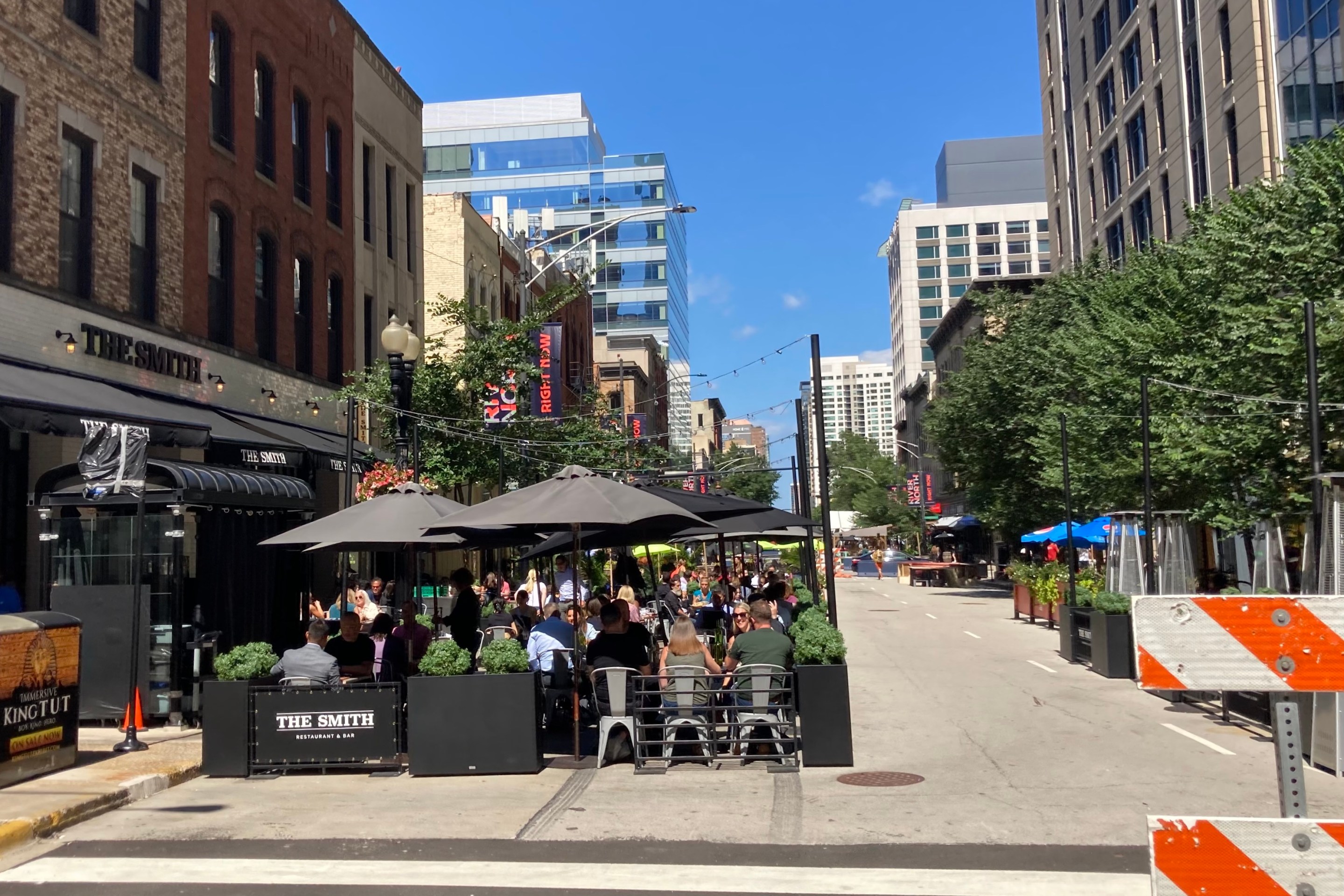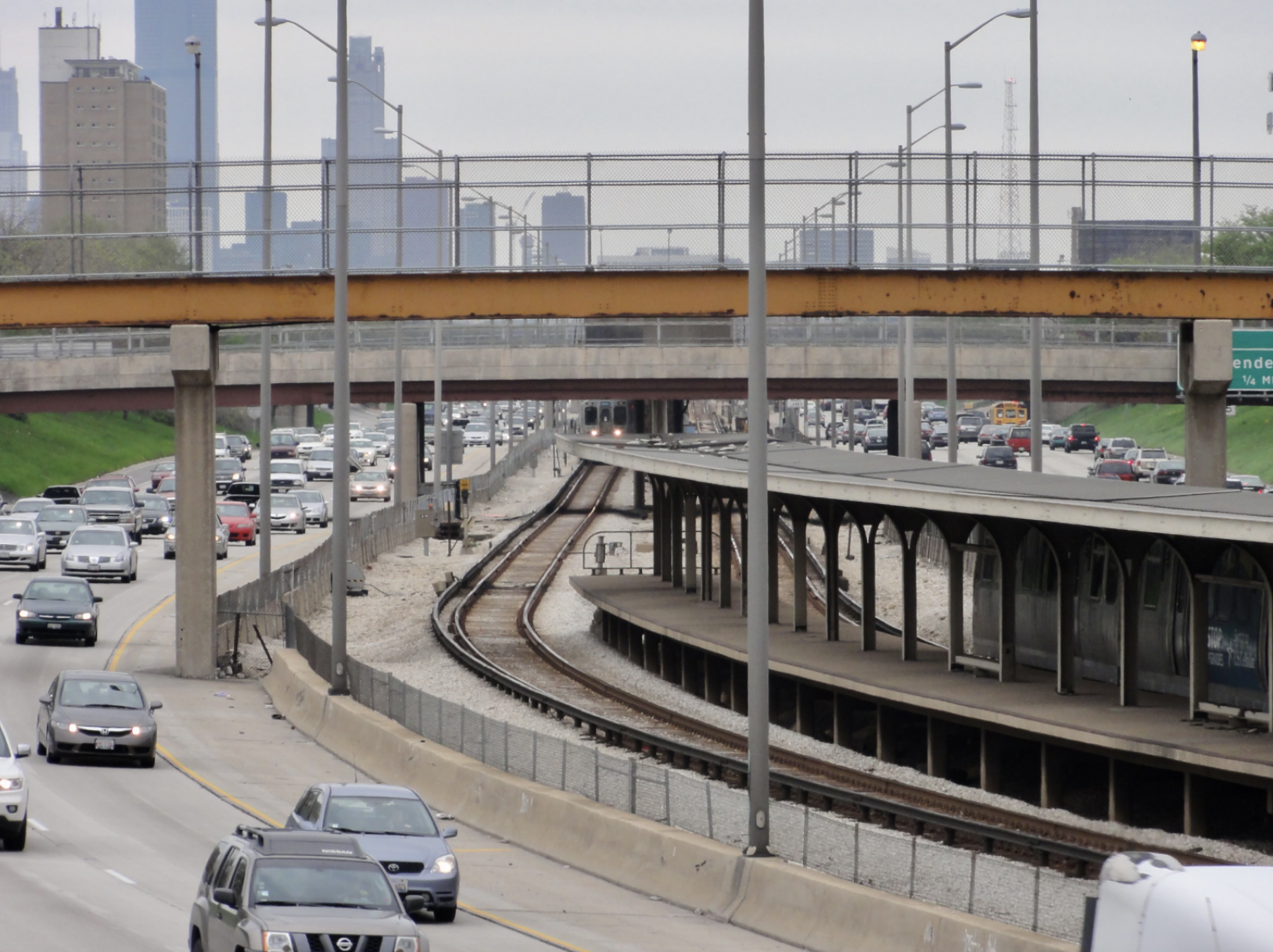Musk Says He’ll Compete to Build O’Hare Express, Active Trans Says It’s a Low Priority
5:51 PM CST on November 30, 2017
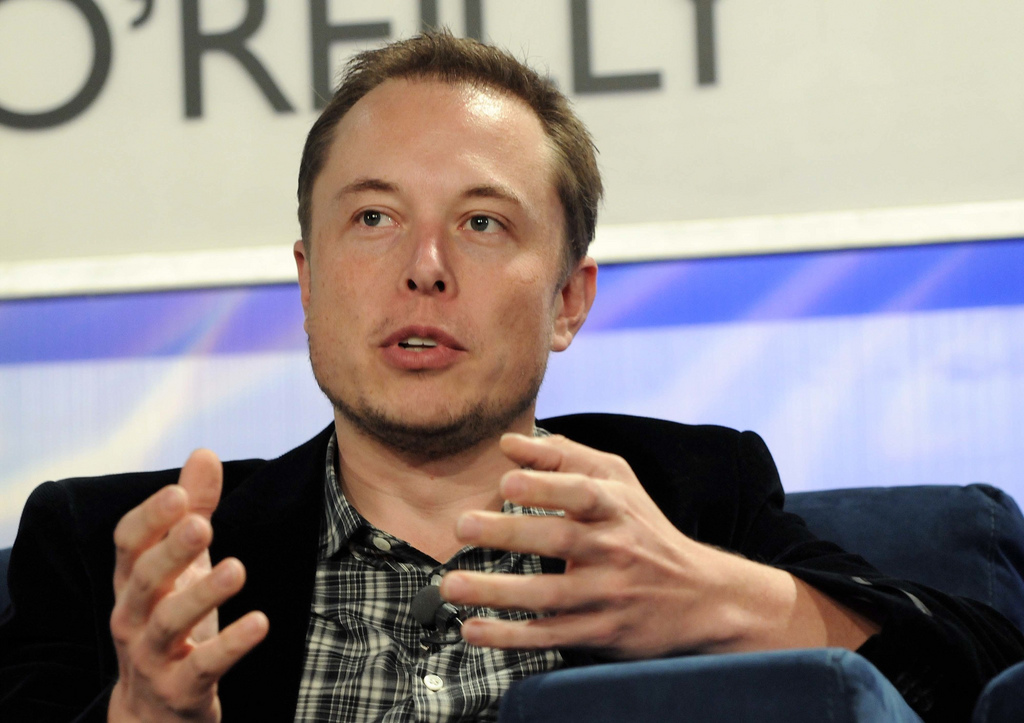
Elon Musk. Photo: JD Lasica
Chicago is abuzz over the news that Mayor Rahm Emanuel’s plan to build pricey high-speed rail between downtown and O’Hare airport is moving forward. Yesterday the city released a request for qualifications for a concessionaire to plan, finance, build, and operate the express service. The document identifies three potential routes and four possible downtown terminals.
The plot thickened last night when tech magnate Elon Musk, who had previously expressed interest in digging a tunnel for the route and transporting air travelers via “electric sled” technology, officially threw his hat in the ring via Twitter. Meanwhile, the Active Transportation Alliance is warning that Emanuel’s pet project for elites could divert resources from much more pressing local transportation needs.
While the CTA Blue Line is already a popular way to get to the airport, the RFQ sets a goal of reducing the travel time from the Loop to the airport from the current 40 to 45 minutes, to 20 minutes or less. Chicago aviation chief Ginger Evans has previously projected that an express ticket would cost between $25 and $35, compared to the current ‘L’ fare of $2.25 to O’Hare and $5 from it, so the new service would largely serve affluent travelers and people on expense accounts.
The first of the possible express routes identified in the RFQ would use the existing Canadian National-CSX railroad corridor. It would travel southeast from the east side of O’Hare, south to suburban Forest Park, head east into Chicago, and turn north at Rockwell Street to join the Blue Line right of way in the center of the Eisenhower Expressway. In this scenario, the downtown terminal would be at Congress and Clinton.
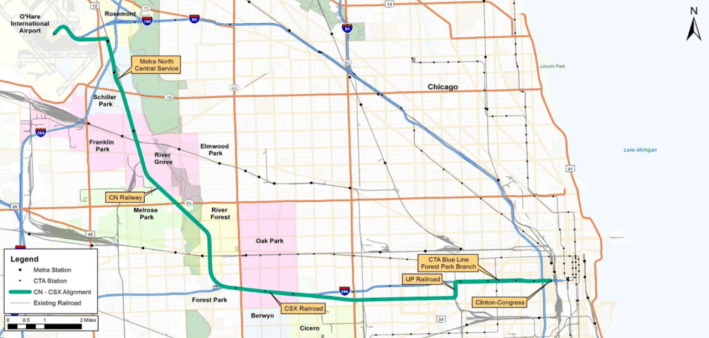
The second potential route would use Metra’s North Central Service alignment, which currently provides an alternative to the Blue Line via the NCS’s O’Hare Transfer station. However, as the RFQ notes, this isn’t currently a popular option for getting to the airport due to limited train frequency and the convoluted method of getting to the terminals – you have to take a shuttle bus from the Metra station to O’Hare’s Airport Transit System people mover.
In this second scenario, the O’Hare Express would use the last mile or so of the Blue Line route to reach the center of the airport. The downtown terminal could be Union Station, or possibly a new facility could be built on the current site of a Metra employee parking lot, southof Kinzie Canal and Clinton.
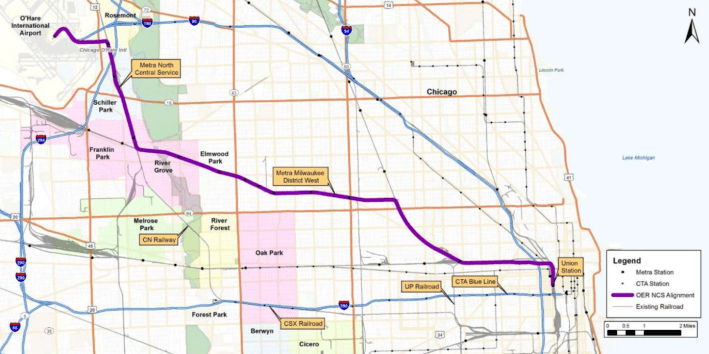
The third possible express route would share the Blue Line corridor coming out of the airport, and then squeeze into the median of the Kennedy Expressway alongside the ‘L’ line until the CTA train enters a subway again, a little north of the Belmont Blue stop. Rather than cramming the express service into the ‘L’ tunnel and onto the elevated tracks in Logan Square and Wicker Park/Bucktown, the concessionaire would be required to build a bypass to continue along the expressway corridor. The express would rejoin the Blue Line corridor near Augusta and Milwaukee and continue downtown to terminate at the Loop's Block 37. The other two potential alignments have many at-grade street crossings while the Blue Line / Kennedy / UP-NW route has none, and it's shorter than the other two, so it may offer the best opportunity for significantly reducing travel times.

Emanuel held yesterday’s press conference for the RFQ release inside the partially completed, roughly $250 million “superstation” Mayor Richard M. Daley built under Block 37 as part of his own futile attempt to create an airport express train. That was an interesting choice of optics on Emanuel’s part, since the empty structure is often viewed as a symbol of civil hubris. While aviation commissioner Evans previously said the superstation wasn’t in the running as an express route terminal due to conflicts with CTA lines, the mayor is now saying the site is currently being considered.
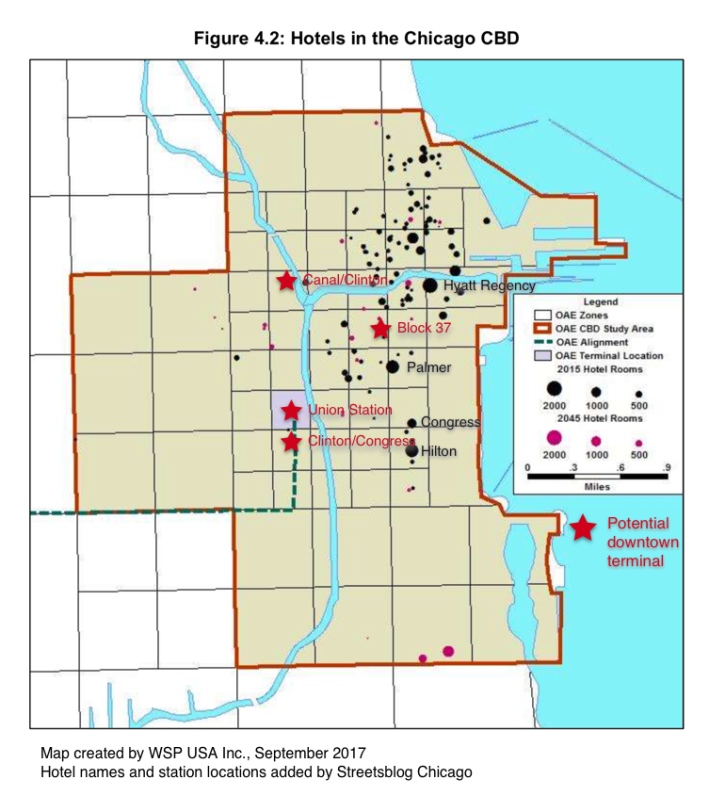
As you can see from this map of downtown hotel locations, to which we’ve added the four potential terminal sites, Block 37 would be by far the most convenient express station location for travelers. The RFQ notes that it would be practical to create a pedway connection from Congress/Clinton to the Blue Line’s Clinton station, and Amtrak and the city are currently planning to upgrade the pedestrian connection from Union Station to that ‘L’ stop. However, it’s less likely that affluent travelers would be interested in taking a 0.3-minute walk with luggage via streets from a Kinzie/Clinton express station to the nearest 'L' stop, the Clinton Green/Pink station.
Any additional travel needed from an express station to one’s destination by CTA, taxi, or ride-share would reduce the timesaving advantage of the high-speed route over the Blue Line, which runs along Dearborn in the Loop, with stations a short walk from several hotels. (The O’Hare Express would run less frequently than the CTA train, every 15 minutes for most of the day, according to the RFQ, which would mean longer waits for its customers.) So the Block 37 superstation is definitely the frontrunner when it comes to making the express service attractive to well-heeled riders.
However, as Crains’ Greg Hinz recently noted, using the Blue Line subway between Block 37 and Wicker Park for the express probably wouldn’t be practical. "The existing Blue Line tracks are crowded, filled and curved," he noted. "It can take 20 minutes just to get out of the Blue Line subway, much less all the way to O'Hare." Therefore, it would likely be necessary to dig miles of new tunnel, an extremely expensive and arduous endeavor.
Or not, if Elon Musk is to be believed. The entrepreneur claims his excavation business, the Boring Company, has proprietary technology that will speed up the digging process 14-fold over conventional methods and cut costs by up to 90 percent, although he’s provided little evidence to back up this boast. In June then-Chicago deputy mayor Steve Koch traveled to Los Angeles to discuss the possibility of a new O’Hare tunnel with Musk. The tech guru said he could run small passenger vehicles through the tunnel using so-called “electric sled” technology. Yesterday Musk announced that the Boring Company will compete for the O’Hare Express project.
The Boring Company will compete to fund, build & operate a high-speed Loop connecting Chicago O’Hare Airport to downtown https://t.co/bRqKpzSJjz
— Elon Musk (@elonmusk) November 30, 2017
In subsequent tweets, Musk clarified that he would use a “high-speed Loop” to transport travelers to the airport, as opposed to his much-ballyhooed (but also largely hypothetical) Hyperloop scheme to use vacuum-sealed tunnels to propel vehicles at more than 600 mph along intercity routes. “A Loop is like a Hyperloop, but without drawing a vacuum inside the tube. Don’t need to get rid of air friction for short routes,” he tweeted yesterday, adding that his proposal for the O’Hare Express would use “Electric pods for sure. Rails maybe, maybe not.”
Amusingly, Musk blocked Streetsblog Chicago on Twitter after we ran a cartoon rendering of his electric sled proposal by local artist Jonathan Roth, featuring muskrats as pod passengers. But whether or not Musk is on the inside track when it comes to tunnel technology, there’s also the question of whether the O’Hare Express is a project worthy of all the high-profile brainstorming that’s currently taking place.
In a blog post published today, Active Trans director of governmental relations Kyle Whitehead argued that, while privately funded high-speed service to O’Hare would be an upgrade to the Chicago area’s transportation network, it shouldn’t be our region’s top transit priority. “The RFQ says there would be no taxpayer funding for the project and the service would be paid for with project-specific revenues,” he wrote. “Still, it’s clear time and attention are being commanded by this project, and these resources could be directed to more efficient and equitable transit solutions.”
Whitehead argued that, rather than focusing our efforts on ways to help business people and affluent folks get to and from the airport more quickly and luxuriously, local leaders should concentrate on improving transit options for ordinary people. “City and county leaders should focus on connecting the spokes in our hub-and-spoke transit system to better serve neighborhoods outside the Loop,” he wrote. “Extending existing rail lines and giving buses priority on our streets with dedicated lanes would be more efficient investments that carry greater benefits for residents.”
In addition to editing Streetsblog Chicago, John writes about transportation and other topics for additional local publications. A Chicagoan since 1989, he enjoys exploring the city on foot, bike, bus, and 'L' train.
Stay in touch
Sign up for our free newsletter
More from Streetsblog Chicago
Tasty news: Friedman Properties is trying to break the Clark outdoor dining stalemate by applying for street closure permits
Mayor Johnson's administration and Ald. Reilly haven't yet found common ground on bringing back the popular car-free zone. Will this make the difference?
Today’s Headlines for Thursday, April 18
Roger that! Streetsblog SF editor Roger Rudick offers constructive criticism of Chicago’s downtown bike network
"There were blocks that felt very safe and very secure," he said. "But then you're immediately – voom! – disgorged into three lanes of moving traffic with no protection."
City announces $2M federal grant to address harms caused by I-290 by improving walk/bike/transit access
The Mayor's Office says the money will fund "improvements for people walking and bicycling on existing streets and paths surrounding and crossing the corridor."
